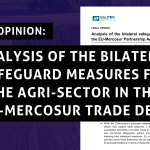All countries have committed to a long term goal of keeping global warming below 2°C compared to pre-industrial levels. In Paris countries are looking into translating the 2°C target into a more concrete long term goal.
While short term urgent action is key to keep the temperature rise below 2°C, most of (developed) countries are still reluctant to take additonal concrete commitments and prefer looking into the future instead.
Long term goals go hand-in-hand with short-term commitments
Therefore one might be quite sceptical towards long term goals: why do we rather try to define what happens 35 years from now? Climate change impacts are already happening and climate change needs to be addressed now and not far in the future?
While these questions are understandable, one must not overlook hte strategic aspect of a full phase out goal for real economy. For businesses having a clear long-term zero goal is important, just as much as we need short-term actions are for the climate. They go hand in hand and if the long-term goal is our end destination, short-term ambitions are our road maps to get there. In terms of the Paris Climate Summit, if our long-term goal is to have a carbon-free economy by 2050, we need to have short-term actions that ensure we get there little by little. Therefore, all countries’ commitments, which can be seen through their Intended Nationally Determined Contribution (INDC), should have in mind this long-term goal.
Biggest polluters are still reluctant to long-term goals
The gap is huge between countries regarding long term goals and reflects the unfairness of climate negotiations. Those most reponsible for the current climate situation are indeed the most averse to engage, contrary to the most affected countries, which are much more enthousiastic.
As it was shown by a recent report of Track 0, Alliance of Small Island States (AOSIS, 44 countries) and Least Developed Countries (LDCs, 48 countries), the two biggest negotiation groups at COP, have clearly stated that they wanted the objective of a global decarbonised economy to be included in the agreement (in 2050 for AOSIS, between 2060 and 2080 for LDCs).
On the contrary, among the 10 biggest polluters, no one has made serious pledge on long term goals in its INDC. Some are low in their ambition, aiming for the end of the century (Brazil for instance), some mention long term targets but without the decarbonisation objective (EU, USA) and most of them don’t even refer to long-term targets (India, Canada, Russia). In this regard, considering how European Union is praising itself for being the world leader on climate negotiations, it is extremely dissapointing to see that its INDC only refers to “the need for at least halving global emissions by 2050 compared to 1990.”
The EU must call for decarbonization by 2050
Through both a long-term goal and short-term actions we will see how sincere the COP will be in committing to climate action. An agreement in Paris with short-term commitments and five-year cycles without a concrete long-term goal might not be perfect. It would lack a perspective beyond 2030, but it would enhance climate protection and greenhouse gas reduction in the next 15 years.
On the other hand, an agreement with an ambitious long-term goal but no effective short-term measures would allow countries to fall far behind with their greenhouse gas reductions and many would just not be able to catch up after 2030.
If the EU needs to revise its position on this issue and call for full decarbonization by 2050.
Until now, we have already warmed by 0,8°C and the likely (66% of probabilities according to IPCC, the UN group of climate experts) carbon budget for staying below 2 degrees is now about 900 Gt CO2. This is therefore urgent to go down immediately and to reach zero emissions the latest by 2050.



